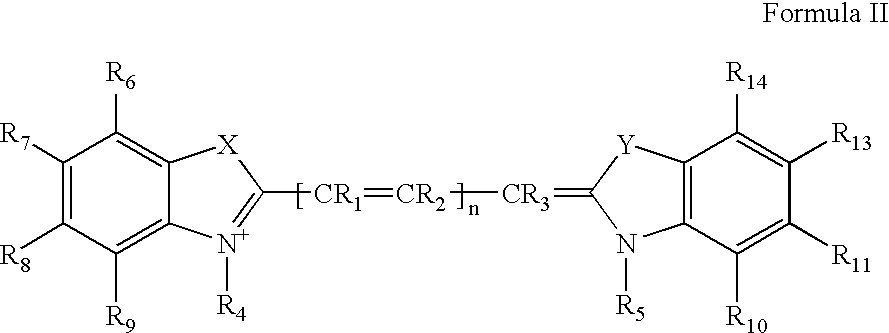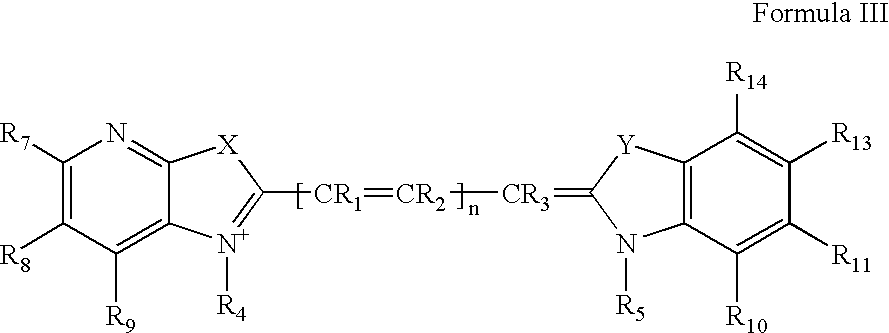Cyanine dyes and their applications as luminescence quenching compounds
a technology of cyanine dyes and luminescence quenching compounds, which is applied in the field of cyanine dyes and their applications as luminescence quenching compounds, can solve problems such as quenching of luminescence, and achieve the effect of increasing the solubility of the final dy
- Summary
- Abstract
- Description
- Claims
- Application Information
AI Technical Summary
Benefits of technology
Problems solved by technology
Method used
Image
Examples
example 1
Preparation of Compound 1
[0143]
[0144] To a solution of thiophene (50 g, 594 mmol) in anhydrous THF (200 mL) is added slowly a 1.6M solution of n-butyllithium in hexane (408 mL, 653 mmol) under nitrogen atomospere at −30° C. The reaction mixture is stirred for a further 2 hours, during which period it is allowed to warm to room temperature. The solution is recooled to 0° C. and a solution of 1,4-dibromobutane (141 g, 653 mmol) in anhydrous THF (100 mL) is added. The stirring is continued overnight. The mixture is diluted with ethyl acetate (1000 mL) and shaken with water (800 mL). The organic layer is washed with brine twice and dried over anhydrous Na2SO4. After removal of the solvent, the residue is distilled in vacuo to afford 2-(4-bromobutyl)-thiophene 1 as colorless oil (66 g).
example 2
Preparation of Compound 2
[0145]
[0146] The potassium salt of 2,3,3-trimetylindolenium-5-sulfonate 2 is synthesized by Fisher indole synthesis through the reaction of 4-hydrazinobenzenesulfonic acid and 3-methyl-2-butanone, followed by treatment the sulfonic acid with a saturated solution of potassium hydroxide in 2-propanol.
example 3
Preparation of Compound 3
[0147]
[0148] The mixture of the potassium salt of 2,3,3-trimetylindolenium-5-sulfonate 2 (7.5 g, 54.1 mmol) and 2-(4-bromobutyl)-thiophene 1 (11.9 g, 54.1 mmol) in dichlorobenzene (6 mL) is heated at 120° C. for 10 hours under nitrogen. The crude product is triturated with 2-propanol. The solid is filtered and washed with 2-propanol and ether and dried under vacuum to give Compound 3 (10.0 g, 98%).
PUM
| Property | Measurement | Unit |
|---|---|---|
| Quantum yield | aaaaa | aaaaa |
| Fluorescence | aaaaa | aaaaa |
| Luminescence | aaaaa | aaaaa |
Abstract
Description
Claims
Application Information
 Login to View More
Login to View More - R&D
- Intellectual Property
- Life Sciences
- Materials
- Tech Scout
- Unparalleled Data Quality
- Higher Quality Content
- 60% Fewer Hallucinations
Browse by: Latest US Patents, China's latest patents, Technical Efficacy Thesaurus, Application Domain, Technology Topic, Popular Technical Reports.
© 2025 PatSnap. All rights reserved.Legal|Privacy policy|Modern Slavery Act Transparency Statement|Sitemap|About US| Contact US: help@patsnap.com



